What I Buy and Why
Print Expert Judy Hecker Once Hunted Down a Work Written With Every Word of Dialogue From ‘Top Gun’
The director of Print Center New York has found that acquiring artworks on paper is a welcome occupational hazard.
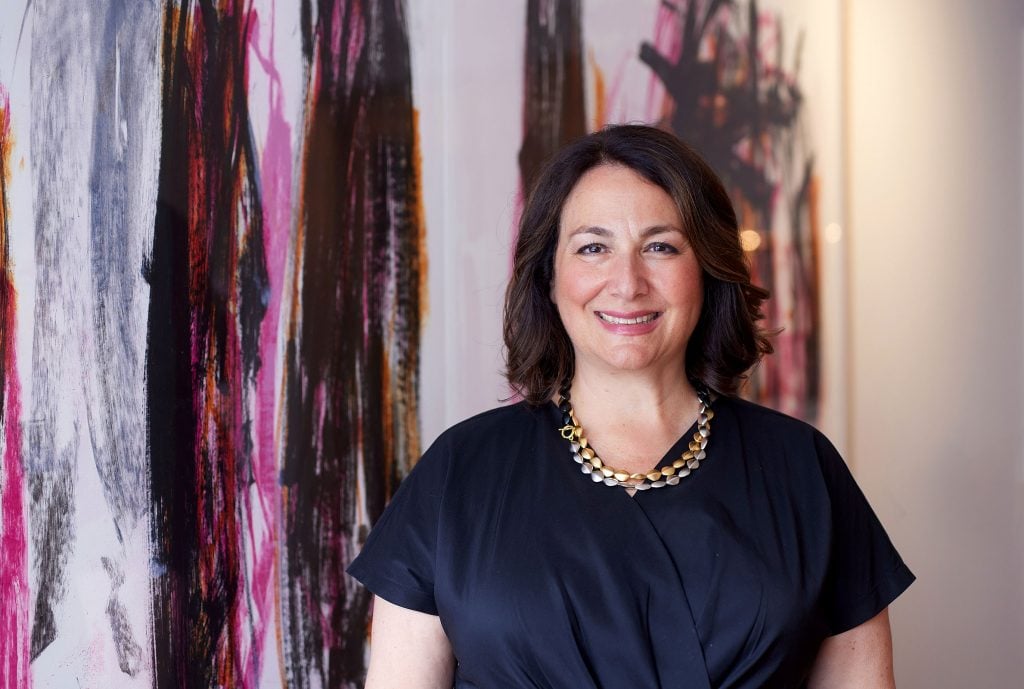
The director of Print Center New York has found that acquiring artworks on paper is a welcome occupational hazard.

Lee Carter

You’d be hard-pressed to find a more dedicated and knowledgeable expert in the field of printmaking than Judy Hecker. Since 2016, she’s served as the director of Print Center New York, the city’s leading nonprofit exhibition space for the paper-based medium. As such, she brings her passion for printmaking to bear on the institution’s programming, broadening the public’s understanding of prints and multiples as a discrete art form that offers real experimentation.
She is the first Print Center director to be appointed by its board—which could be confident in its decision. Going back to 1997, Hecker served as assistant curator in the Drawings and Prints department at the Museum of Modern Art, where she helped the curatorial team with acquisitions and organized numerous print-based exhibitions, most recently “Impressions from South Africa: 1965 to Now” and “William Kentridge: Five Themes.” Before that she cut her teeth as a curatorial assistant at the Whitney.
There’s a lot to love about prints, Hecker is quick to point out. “The thing about prints is that they rarely disappear altogether,” she said. “When a painting sells, you may never see it again, unless on loan or gifted to a museum, or if it changes hands.” Prints resurface, Hecker explained, because “they’re created in editions—be it five or 35 or 105—and so even if you miss out, there’s always another one lurking.”
The result is that prints are not only more affordable, she noted, but “far more collectible.” Which may explain the breadth and diversity of her own collection, a mix of artists who make printmaking a core of their practice—Ed Ruscha, Charline von Heyl, Richard Tuttle, Jenny Holzer, William Kentridge, and James Siena—and others who see it as an important extension of their work, artists like Mamma Andersson, Vija Celmins, Peter Doig, Gary Hume, Guillermo Kuitca, and Rirkrit Tiravanija.
We caught up with Hecker on her love of prints and her drive to collect them.

Gary Hume’s screenprints Brown, Brown, Silver and Brown, Pink Nicola, and Nicole as Orchid (2005) on right wall, Vija Celmins’s aquatints Untitled (Web 3) (2002) and Concentric Bearings A (1984) on left wall. Photo: Argenis Apolinario. Courtesy of Judy Hecker.
What was your first purchase?
My first purchase together with my husband was the result of a little chase, and being in the right place at the right time. The British artist Fiona Banner had been making monumentally sized ‘wordscapes’ at the time (in the late 1990s) that captured her own verbatim but full-text descriptions of entire films, from war films to classic blockbusters. They were utterly engrossing but utterly enormous and impractical for our New York City apartment. However, I had heard about her very first—and rare—wordscape, Top Gun. At an improbable 12 x 25 inches, it packs in the total dialogue and description of the iconic Tom Cruise film. She created a micro-drawing (yes, handwritten!) in 1994 and a subsequent print in 1996. We were in London and offhandedly inquired about the print at Banner’s gallery and they had one left—it came rolled up in a perfect custom printed box; we popped it in a layer of bubble wrap and were on our way. You cannot deny the portability of prints. Banner’s work—also under the moniker of her imprint the Vanity Press—is full of humor and conflict and tragedy. That purchase led us to buy her book Nam, a 1,000-page meditation and compilation of complete text descriptions of all the well-known Vietnam films; and her ISBN print, which is just that: an oversized ISBN number beautifully printed in black ink on silver paper.
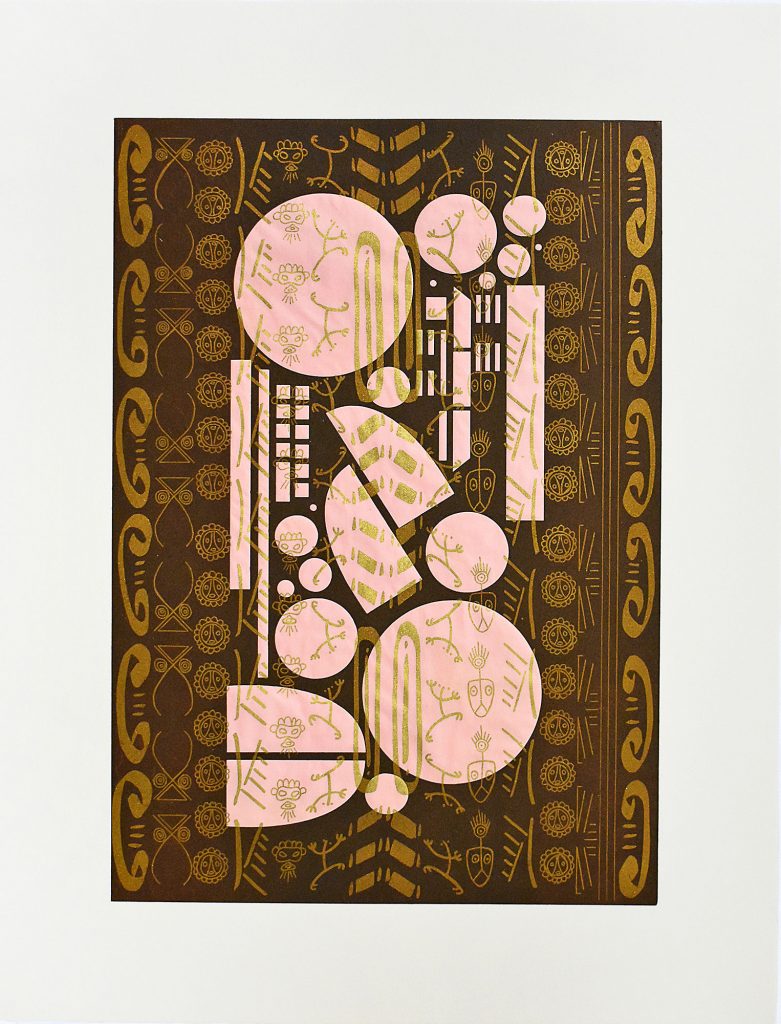
Glendalys Medina, BrownPinkTaínoBlackGold (2018), photolithograph printed in gold ink on pink Yatsuo paper, flocked with gold pigment. Courtesy of the artist.
What was your most recent purchase?
Earlier this year we bought a print by Glendalys Medina, a Bronx-based artist who works in a variety of mediums and has printed with the historic Robert Blackburn Printmaking Workshop in New York. Titled BrownPinkTaínoBlackGold (2018), the print combines abstraction with marks and references to hip-hop culture and the history of Puerto Rico and the Taíno people. This particular print is flocked with gold pigment, uses pink and white paper, and is highly patterned. It’s a textured and layered visual experience that links to significant personal and political references for the artist. I’m learning about her work and really hope she creates more prints at Blackburn.
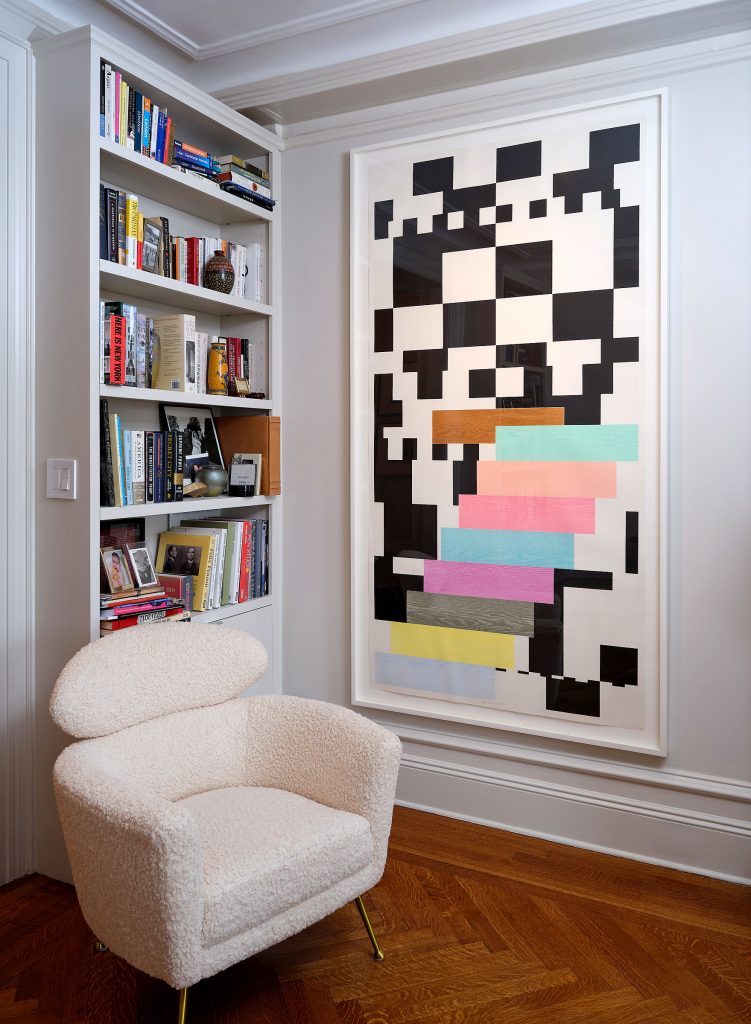
Richard Tuttle, Step by Step (2002), woodcut coated with veneer and laser cut. Photo: Argenis Apolinario. Courtesy of Judy Hecker.
Tell us about a favorite work in your collection.
Richard Tuttle’s work can be a puzzle, a pause, a double take, a moment of dismay—in the best possible way. And his prints are no exception; he has rules and regulations that govern their making as well as their framing and display—and his collectors, we hope, oblige. I’ll admit, I cheated to fit his nearly seven-foot print Step by Step (2002) on my wall (forgive me, Richard!) as there should technically be more floating space inside the top and bottom of this frame. But I digress…I love this print—his largest to date—because people who see it try to deconstruct how it’s made (it plays with reversal and positive/negative space by printing woodblocks in black ink and incorporating the white of the paper), and the whole edition is a puzzle; each of the 41 has slight variations to its colored parts. I like that you can see the grain of the wood so clearly in the colored sections.
Which works or artists are you hoping to add to your collection this year?
I’m eyeing a couple things. For me, collecting has become less about individual artists and more about following printer-publishers whose programs I am excited by and who are developing relationships with artists that are either new to printmaking or are working with a particular printer for the first time. It’s part of my job, along with the talented on-the-ground staff at Print Center New York, to follow what’s new, and occasionally adding works to my collection is a welcomed occupational hazard.
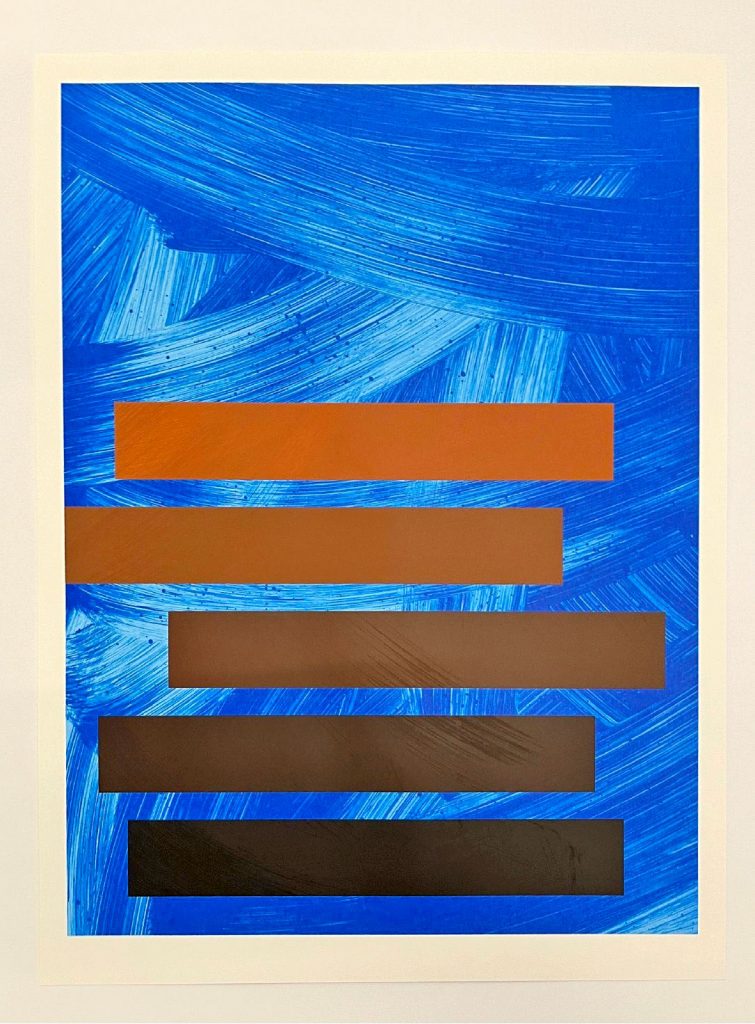
Tariku Shiferaw, Don’t You Wait (Solange) (2023), color screenprint. Courtesy of Judy Hecker.
We are piloting a series now called Publisher Spotlight in our lobby space as a way to bring the public in direct contact with new prints that haven’t had exposure in Chelsea yet. So I have my eye on prints by Glen Baldridge and Tariku Shiferaw (Shiferaw has a powerful show on now at Galerie Lelong & Co.), artists that have collaborated with Leslie Diuguid of Du-Good Press in Brooklyn, who we are featuring in our first Publisher Spotlight. All the works on display are sold directly through the publisher. We have an opening with Leslie on October 4, so people will have the chance to speak with her and meet the artists.
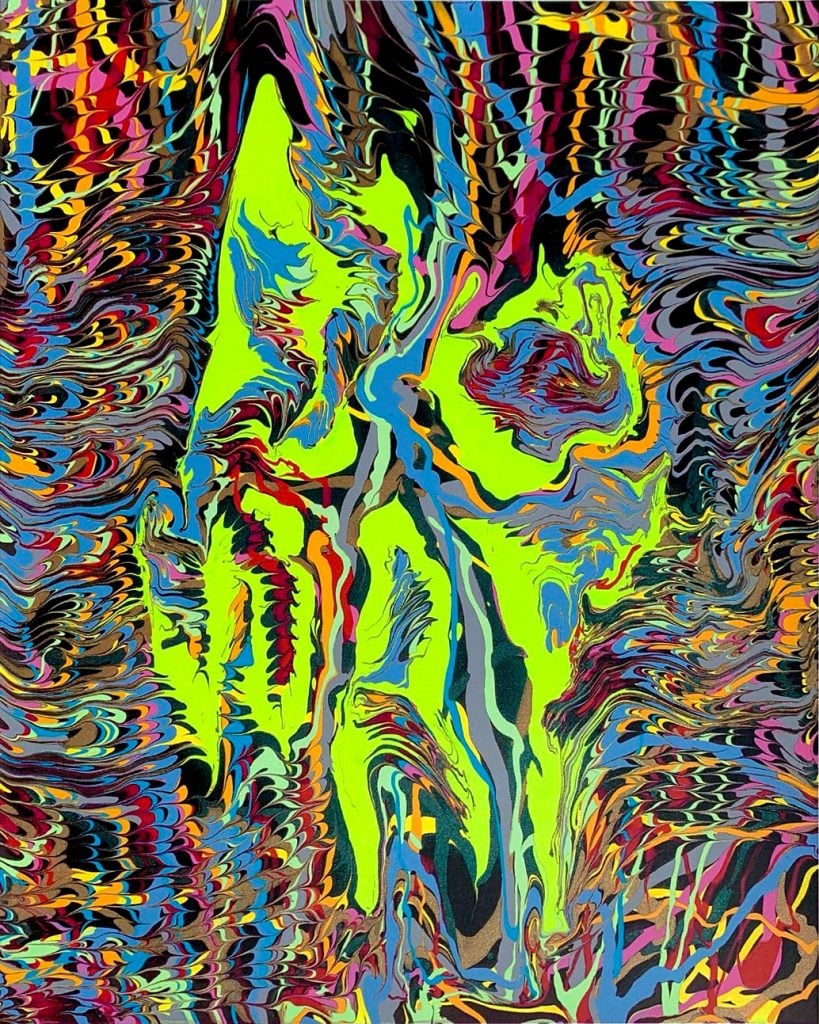
Glen Baldridge, No Way (2022), color screenprint. Courtesy of Judy Hecker.
What is the most valuable work of art that you own?
The most valuable are the invaluable, however you choose to define that. For me, one artist that stands out in this category is Felix Gonzalez-Torres and his “give-away” poster-prints. These are installed as stacks of paper on the floor of museums or gallery shows and are so compelling as minimalist structures—admittedly, the sheets can be cumbersome to “own,” that is, to take, get home, and store. You roll them up, put them someplace safe, and sadly can forget where. Somewhere, I have a tube of Gonzalez-Torres’s posters that I collected at the Whitney, like his Untitled (Death by Gun) (1990) and his images of clouds and a soaring bird. These are about violence, love, loss.
Not long ago, I collected a give-away offset print showing a cartoonlike gravesite of a Klansman (with a daisy on top), titled Everyone Should Have One on Their Wall, by artist Mark Thomas Gibson; this one I stored carefully and know the location of. Gibson really leans into the idea of ubiquity with this image, changing it slightly and making it available at exhibitions and art fairs over time. Like Gonzalez-Torres, this is a print, it just doesn’t have a price tag and is an open edition. What you decide to do with these is up to you—and those actions (to save, display, toss, or one day sell) become part of what defines the work and the audience’s role in its meaning.
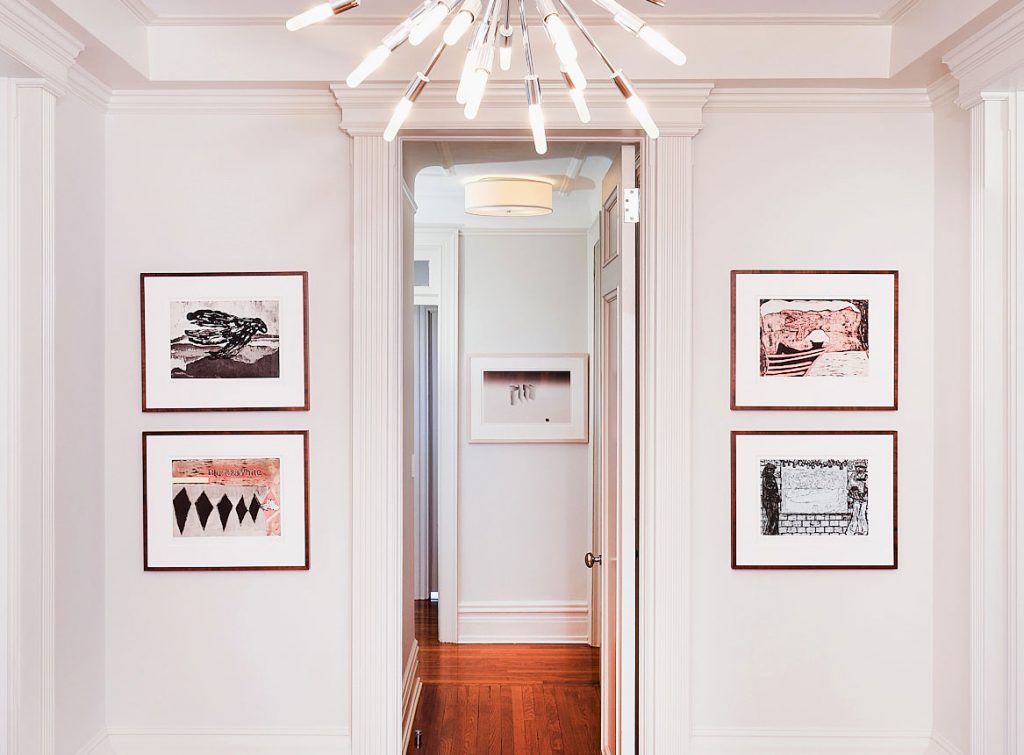
Four untitled prints by Peter Doig, from a 2013 portfolio, with Ed Ruscha’s Sin with Olive (1970) lithograph in the center. Photo: Argenis Apolinario. Courtesy of Judy Hecker.
Where do you buy art most frequently?
Print fairs, book fairs, art fairs. I’m looking forward to late October when the IFPDA Print Fair opens at the Javits Center (check out their site for more info about the panel we’re hosting there). This is where you can see new editions by print publishers from across the country and internationally. You also get to see historical gems that have surfaced for sale.

William Kentridge, Hope in the Green Leaves (2013), linoleum cut. Photo: Argenis Apolinario. Courtesy of Judy Hecker.
Is there a work you regret purchasing?
There’s nothing I regret, just the fact that we don’t have enough wall space to hang everything. I have a propensity for (my husband might say an addiction to) buying works under a certain price point at art fairs in a rather spur-of-the-moment fashion. But it’s hardly a regret; we just need more walls!
What work do you have hanging above your sofa? What about in your bathroom?
Above our sofa we have an early series of seven small etchings by Julie Mehretu that we purchased at auction. We’d been eyeing her work for some time, and we lunged at the opportunity many years ago for this set called Landscape Allegories (2004). Mehretu created it with the specialist boutique etching workshop Burnet Editions, where the artist has worked periodically over the years. The set lays out her early interest in exploring history, civilization, landscape, and the political. Regarding the bathroom, somehow I have tiles all the way up my walls. What was I thinking?
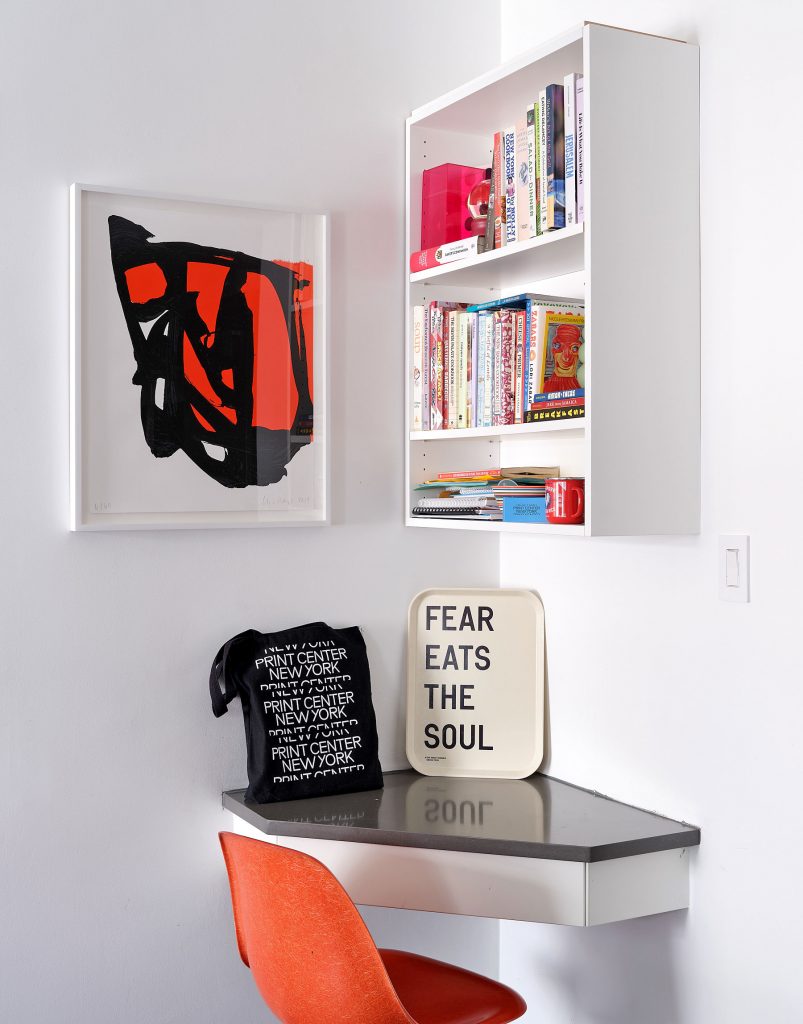
Charline von Heyl, Zonzomas (2019) silkscreen on wall, Rirkrit Tiravanija Fear Eats the Soul tray (2018) on desk. Photo: Argenis Apolinario. Courtesy of Judy Hecker.
What is the most impractical work of art you own?
The most impractical may, in fact, be the most practical. A Rirkrit Tiravanija multiple from 2018 that is a cafeteria-style lunch tray printed with this text (also its title): FEAR EATS THE SOUL. It’s classic Tiravanija in that it defies the art/life division we normally subscribe to objects, and puts the pun “eats” front and center in a riveting statement or challenge (the title is actually a reference to a Fassbinder film). So, it’s impractical because it’s hard to display as “art,” but it’s quite practical as a tray—though I don’t want to ruin it by using it.
What work do you wish you had bought when you had the chance?
There are too many to name, it’s painful! For instance, when I saw “Edward Hopper’s New York” at the Whitney last year, I was drooling over all the spectacular etchings of New York interiors and exteriors—who doesn’t want a little Night Shadows or Night in the Park on their wall? These are so emotive and capture our great city in all its complexity. His prints have gotten pretty expensive over the years, so lots of misses there, however he’s far from the only one to capture this period in etched black ink. I am reminded by our newest exhibition just how many talented artists of that period have captured essential New York City scenes.
If you could steal one work of art without getting caught, what would it be?
Picasso’s The Weeping Woman (1937), preferably the seventh (and final) state. I became obsessed with its story and making while at MoMA. The print is a glorious and devastating elaboration in etching of one of Picasso’s figures in the painted mural Guernica. Technically, it’s drypoint, etching, aquatint, and scraper. The print was developed over time in what are called “progressive states” in printmaking. If you ever have the opportunity to see multiple states, it is something to behold that isn’t possible in any other medium.